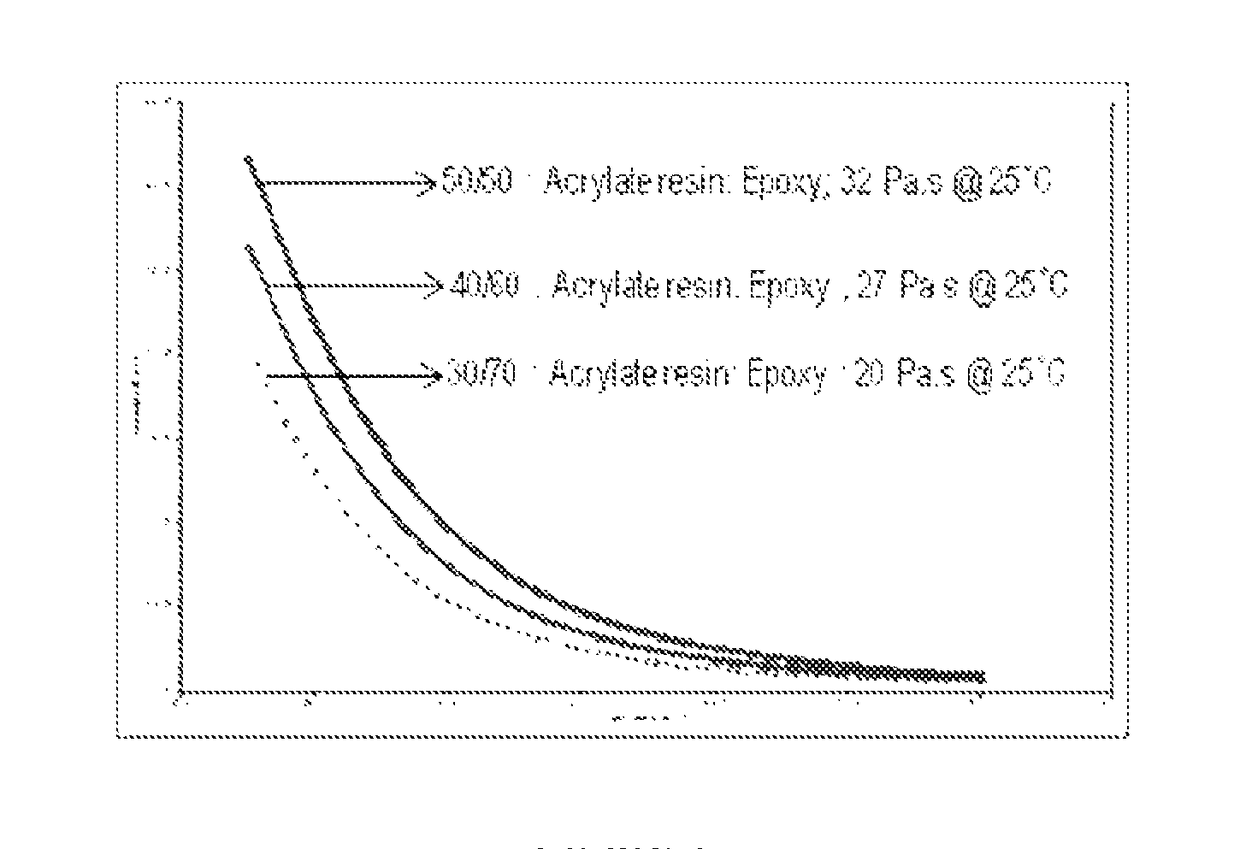Polyurethane-acrylate epoxy adhesive
a polyurethaneacrylate and epoxy adhesive technology, applied in the direction of adhesives, adhesive types, adhesive processes, etc., can solve the problems of limiting the use of polyurethane, affecting the adhesion, and affecting the adhesion effect of the adhesiv
- Summary
- Abstract
- Description
- Claims
- Application Information
AI Technical Summary
Benefits of technology
Problems solved by technology
Method used
Image
Examples
example 1
[0097]All raw materials are used as received except where noted otherwise. The Dow Polyol Voranol CP-6001 is a 15% EO capped polyol having a molecular weight of 6000 g / mol and a functionality of 3. The polyol is dried and subsequently prepolymers are made using TDI (T-80) (Aldrich).
[0098]103.7 g (595 mmol) toluene diisocyanate (TDI, 80 / 20 mixture of 2,4- and 2,6-isomers) are charged to a dry 2 L 4-neck round bottom flask equipped with overhead stirring, temperature control probe, addition funnel, and nitrogen inlet. The flask and its contents are heated to 80° C., and 1104 g (540 mmol) of a 6000 molecular weight, nominally trifunctional, low terminal unsaturation polyethylene terminated poly(propylene oxide) triol (Voranol™ CP 6000 from The Dow Chemical Company) is added. The solution is stirred for 30 minutes after the diol is added. A drop of dibutyltin dilaurate is added and the reaction stirred for an additional 2 hours. The product is an isocyanate-terminated prepolymer having ...
example 2
[0101]The acrylate is combined with epoxy in the weight ratio of 30:70 (Acrylate:Epoxy). 6 g of the acrylate-terminated polyether produced in A above and 14 g of a 180 epoxy equivalent weight diglycidyl ether of bisphenol A (D. E. R. 383, from The Dow Chemical Company) are mixed on a high-speed laboratory mixer until homogeneous. This results in composition A1.
[0102]Separately, a 50:50 mole ratio blend of Thiocure DMPT, (2,3-bis ((2-mercaptoethyl)thio))-1-propane thiol) is obtained from Bruno Bock (0.04 moles) and isophorone diamine (0.04 moles) is mixed with 10 mg (0.066 mmole-% based on thiol groups) of 1,8-diazabicyclo[5.4.0]undec-7-ene (DBU, Sigma Aldrich technical grade). The thiol / amine / catalyst mixture (Composition B) is then mixed with the acrylate-terminated prepolymer / epoxy resin mixture on the high speed mixer to produce a clear mixture. These proportions of starting materials provide one combined equivalent of thiol and amine hydrogens per combined equivalents of acrylat...
example 3
[0103]Example 2 is repeated, except the blend ratio of acrylate and epoxy is 40:60. This results in composition A2. The curing agent contains a 50:50 mole ratio of trimethylolpropane tris(mercaptopropionate) and isophorone diamine. The proportions of starting materials provide about 1 combined equivalent of thiol and amine hydrogens per combined equivalents of acrylate and epoxide groups.
PUM
| Property | Measurement | Unit |
|---|---|---|
| viscosity | aaaaa | aaaaa |
| mass | aaaaa | aaaaa |
| equivalent weight | aaaaa | aaaaa |
Abstract
Description
Claims
Application Information
 Login to View More
Login to View More - R&D
- Intellectual Property
- Life Sciences
- Materials
- Tech Scout
- Unparalleled Data Quality
- Higher Quality Content
- 60% Fewer Hallucinations
Browse by: Latest US Patents, China's latest patents, Technical Efficacy Thesaurus, Application Domain, Technology Topic, Popular Technical Reports.
© 2025 PatSnap. All rights reserved.Legal|Privacy policy|Modern Slavery Act Transparency Statement|Sitemap|About US| Contact US: help@patsnap.com



